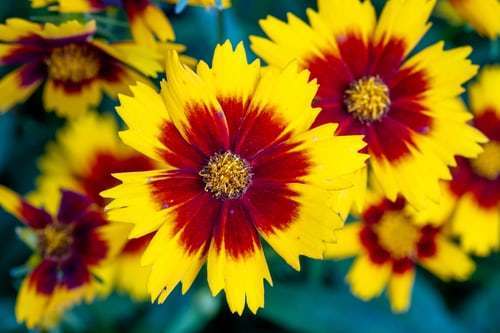Although typically seen in shades of yellow and gold, many species also contain red, bronze and burgundy and have been commonly used as natural dyes. Indigenous people boiled the flowers into teas before the introduction of coffee. In recognition of the importance of the genus, Florida and Mississippi have named coreopsis as their state’s wildflower.
There are about 80 Coreopsis species, all at home in the Americas, with 38 listed as native to the contiguous United States. Like other members of the Asteraceae, which comprises a broad collection of daisy-like flowers commonly called composites, coreopsis blossoms are made up of two primary elements: colorful ray flowers surrounding a cluster of typically bronze or brown disk flowers. Botanists opted to name our cheerful floral friend with reference to the appearance of its seed rather than the beauty of its flowers—unlike its cousins in the sunflower group (Helianthus, Heliopsis and Helenium). Hence the common name tickseed, which derives from the Greek koris, or bed bug, and opsis, appearance. Regardless of this less-than-endearing description, coreopsis carries on with its always cheerful show of abundant, colorful flowers in the spring and summer garden.
Key Species and Cultivars
Coreopsis can be winter hardy to USDA Zone 3 (C. verticillata, C. tripteris) and range into the extreme heat of Florida and the Southwest (C. floridana, C. tinctoria). Many of the species are self-seeding and considered annuals (such as C. tinctoria), however garden favorites include the perennials whorled tickseed (C. verticillata), lobed tickseed (C. auriculata) and large-flowered tickseed (C. grandiflora). The C. grandiflora cultivar ‘Early Sunrise’ was designated an All-America Selections Winner in 1989 and it remains among the best-selling coreopsis for garden use. Other important cultivars include C. verticillata ‘Moonbeam’ and ‘Zagreb’ and C. auriculata ‘Nana’.

Plants in the UpTick series, such as this one named Cream & Red, boast a compact, mounded shape that recommends them for containers or the front of the flower border.
Coreopsis species have been heavily hybridized for decades to improve plant flowering, flower size and disease tolerance. ‘Sunkiss’ (C. grandiflora ‘Sunkiss’) and the C. xhybrida Big Bang™, HARDY JEWEL™ and UpTick™ series are among the most significant newer introductions, representing dedication and years of effort by plant breeders. There are dozens of commercially available cultivars varying in height from six inches to three feet and covering a broad color range, from the traditional yellow to caramel, bronze, red, gold, rose and cream-white. They can be incorporated into nearly any area of the garden where their height and color are needed.
Growing Coreopsis
Gardeners have successfully cultivated coreopsis for centuries. This is due in large part to the carefree nature of the genus. The J.T. Lovett Company of Little Silver, N.J., listed C. lanceolata as “one of the finest hardy plants grown” in their 1891 catalog, adding that “a bed of it in full bloom is a sight indeed!” Today, coreopsis falls within the top 10 genera of cultivated perennial plants.
Species and cultivars available in today’s retail outlets prefer sunny locations with well-drained soils, as they are typically derived from the northern and prairie species. Cultivars of C. verticillata are known to expand their territory by underground rhizomes and should be dug periodically, unless the gardener wants them to take over the space allotted altogether.

‘Nana’, a cultivar of Coreopsis auriculata, is a bit unique among tickseeds because it can flower under a shorter day length. Most others need at least 12 hours of daylight to bloom.
Coreopsis are considered to be long-day obligate plants, which means that they need more than 12 hours of daylight (typically 13 to 14 hours) to produce flowers. One notable exception is C. auriculata ‘Nana’, which flowers under shorter day length. Most cultivars will re-bloom when old flowers are removed. This can be accomplished by removing spent flowers one by one, or by shearing the entire plant to half of its original flowering height. Re-blooming should occur within a few weeks.
Given their abundance of flowers, coreopsis draw a multitude of bees and butterflies to their blossoms and birds to their seeds. They also tolerate drought. Coreopsis in the garden does benefit from fertilizer in the spring to encourage new growth. They are equally at home in containers as the ground, and they will provide the same show and interest as a container plant. In particular, consider cultivars in the C. grandiflora and C. xhybrida group for container use.
Karl Batschke is Global Products Manager for Darwin Perennials. This article was developed and provided by the National Garden Bureau.
KARL BATSCHKE www.hortmag.com
Image credits:
‘Zagreb’ and Uptick Cream & Red courtesy of Walters Gardens
‘Nana’ by Patrick Standish/CC BY 2.0





